King Arthur, the Red Dragon and improbable Blayney links
There have been numerous claims to a relationship with the legendary King Arthur (of the Round Table), surrounded now in more myth and legend than established fact, so recording a few more possibilities adds more mystery and intertest than any true scholarship. However, I have tried to summarise the historical background of the Arthurian legend, but the topic is so vaste this can only be a glimpse at best.
It has been noted that "Cadwaladr" is likely to be derived from from Cad = 'battle', and gwaladr = 'lord, leader or chieftain', ie 'battle-leader' and thus synonymous with Dux Bellorum
The possible Blayney links to King Arthur are:
- Gwenwynwyn of The Scots See Discussion1.
- King Cadwaladr (two discussed). See Discussion2.
- Caradog Vreichvras (Fraichfras), King of of Gwent See Discussion3.
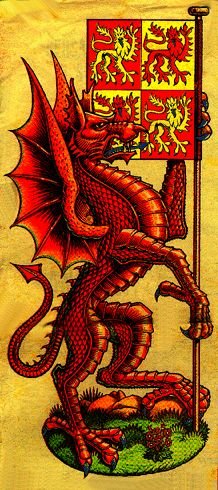 |
The History of King Arthur and the Red Dragon
The Red Dragon, one of the most ancient badges in the world, was brought to Britain by the Romans, who had copied it from the Parthians. Following the departure of Roman legions (to face a threat to Italy by the Goths), the newly weakened state of Britain came under increasing threat of invasion by the Saxons from Denmark. The next six hundred years saw battles and rivalry between the forces of the Celts (with the Red Dragon symbol, as on the Welsh flag) and the Saxons (with the White Dragon).
 | ||
| The Welsh flag | ||
Around these two warring forces grew the legends of Merlin and King Arthur, probably a Romano-British tribal chieftain or warlord who helped unite the brave but comparatively disorganized Celts of Cornwall, Wales, Northumbria and possibly the Scottish lowlands sometime in the 5th - 6th century.
According to Geoffrey of Monmouth's "History of the Kings of Britain" (c.1100 BC-689 AD) [2], there was Vortigern, Vortimer, Aurelius Ambrosius [b c433-38 d in the 480s], second son of Constantine, his brother Uther Pendragon then Uther's son Arthur (? died 542). These names are familiar to any reader of Mary Stewart's "The Crystal Cave", "The Hollow Hills" and "The Last Enchantment".

"The Angles and Saxons sought to increase their lands, but there arose another leader after Vortigern, Ambrosius, "the sole survivor of the Romans", who became monarch after Vortigern, quelled the presumptuous barbarians with the help of Arthur." (WofM). It is interesting to note that William makes the following statement, as a contemporary of Geoffrey of Monmouth: "This is that Arthur, of whom the Britons fondly fable even to the present day; a man worthy to be celebrated, not by idle fictions, but in authentic history." William credits Arthur with the victory of Mount Badon, which created a peace which lasted for some time. However the Angles and Saxons continued to pour forth from their homelands and the Britons were gradually forced back. [3]
Another school of thought has the legendary King Arthur based on Prince Arthur of Argyll (Prince of Scotland) b.559, d.603 who married Gwenhwyfar De Bretagne (Guinevere of Brittany, daughter of Leo de Grance). See Prince Arthur.
[b] The Welsh Easter Annals or Annales Cambiæ, supposedly written over the years that they cover, AD 447 to 957 (very early entries probably written some time after the events), This document records historical events alongside many of its yearly entries.
[c] "History of the Britons" by the Welsh historian Nennius, ?a monk from Bangor Fawr (Gwynedd) in the 8th century. Nennius used numerous chronicles to put together this compilation history of the British peoples. The work is particularly noted for its chapter concerning the Campaigns of Arthur, telling of his twelve battles.
The Ruin and Conquest of Britain 400 A.D. - 600 A.D: A Summary of Gilda's Account c545: [5] In 400 A.D. most of Britain (the part south of Hadrian's wall) had been part of the Roman Empire for over three and a half centuries, and all free-born Britons had been Roman citizens for half that time. Christianity was well established and the cities remained relatively prosperous, if somewhat less so than in the past. In the preceding half century there had been a number of worrying raids by barbarians: the Picts from north of the Antonine wall, the Scots from Ireland and the Saxons, which was the generic term used in the Roman world for the north-western Germanic tribes including Angles, Jutes and Fresians as well as Saxons. The Roman general Magnus Maximus had largely countered the Pictish threat by enlisting the British tribes between the Hadrianic and Antonine walls as federate allies of the Empire. However, he subsequently withdrew most of the Roman troops in his failed bid to usurp the Imperium from 383 to 388.
RELEVANT HISTORICAL TIMELINE
[6], [7]
402 Stilcho withdraws some legions from Britain to face a threat to Italy by the Goths
and for an interesting further note........ and now jump ahead to a century after Arthur's death and one again finds another Cadwallader
c.425 Vortigern comes to power as the head of a council of Britain. Dies in a fire in 447.
c.449 Vortigern (possibly Britu,using the title "Vortigern = Overlord see Overlord) invites Jute/Fresian mercenaries under Hengest, and settles them in Thanet, to use in punitive raids against the Picts, and possibly also to counter the threats of British rivals and Imperial invasion.
c.456 Vortigern's son Vortimer takes power and repudiates his father's agreement with Hengest. He invades Kent but is defeated by Hengest at Crayford and driven back to London.
?471 Vortigern takes power again, and invites Hengest and his army back.
?472 In a meeting with the council of Britain, Hengest's men murder all 300 British elders by surprise, and ransom Vortigern for Essex and Sussex. Vortigern hands over power to Ambrosius Aurelianus.
c.460-72 Ambrosius Aurelianus of pro-Roman faction takes full control of Britain; leads Britons in years of back-and-forth fighting with Saxons. British strategy seems to have been to allow Saxon landings and to then contain them there.
c.465-70 'King' Arthur probably born around this time.
c.466-73 Period of minimal Saxon activity. Re-fortification of ancient hillforts.
473 Men of Kent, under Hengest, move westward, driving Britons back before them "as one flees fire."
c.475 Ambrosius Aurelianus rallies the Britons and defeats the English (Angles & Saxons). Fortunes of war fluctuate until 518. His "brother" Uther Pendragon, takes over when Ambrosius is poisoned. He is, according to the medieval historian Geoffrey of Monmouth, the father of King Arthur. There is no proof that Uther Pendragon really existed, though scholars believe he may have lived sometime during the mid-late 400s. Some think he was Enniaun Girt, son of Cunorix (Kenneth) of the Votadini (from Edinburgh). To the ancient Welsh and Britons the fearsome dragon became known as the 'Pendragon', the chief dragon, a symbol of national pride and of war [8]
This was then the name given to 'Uther, High King of Britain'. This name was the title of Kings, and therefore given to 'Arthur' upon the death of Uther, the 'dux bellorum', 'the leader in war'.
477
Saxon chieftain, Aelle, lands on Sussex coast with his sons. Britons engage him upon landing but his superior force besieges them at Pevensey and drives them into the Weald. Over next nine years, Saxon coastal holdings gradually expand in Sussex.
c.485-96 Period of Arthur's "twelve battles" during which he gains reputation for invincibility.
c.495 Arthur takes over from Ambrosius as Dux Bellorum (battle-leader) of the Britons. He is victorious over the English in Lindsey, the Picts (presumably) in Caledonia and the Irish (presumably) in Carleon.
The Germanic King Cerdic and his son, Cynric, land somewhere on the south coast, probably near the Hampshire-Dorset border. They establish the beginnings of the Kingdom of Wessex. King Gwynllyw of Gwynllwg carries off Princess Gwladys of Brycheiniog. War between the two kingdoms narrowly avoided by the intercession of the legendary Arthur. The couple marry.
c.496 The Siege of Mount Badon. Britons, under the command of the "war leader" Arthur, defeat the Saxons, under King Esla of Bernicia and possibly Cerdic of Wessex.
c.516 Battle of Badon -according to Annales Cambiæ
518 Battle of Badon (Bath) -according to Gildas- in which Arthur defeats the English. Aelle (probably the English leader) and Cerdic die. Britain is partitioned by treaty between the British and the English. Gildas is born.
c.496-550 Following the victory at Mt. Badon, the Saxon advance is halted with the invaders returning to their own enclaves, many (in the 530s) Saxons migrate back to Germany. A generation of peace ensues. Corruption, civil turmoil, public forgetfulness and apathy further erode Romano-British culture over next fifty years, making Britain ripe for final Saxon "picking."
c.500-17
King Cadwallon Lawhir (?brother of Cadwalladr,) expels the Irish from Anglesey.
508 King Cerdic of Wessex begins to move inland and defeats British king, Nudd-Lludd (Natanleod), at the Battle of Netley.
517 Death of King Cadwallon Lawhir of Gwynedd. His son, Maelgwn takes the throne, murders his uncle, probably King Owain Danwyn (Ddantgwyn) of Rhos (claimed as Arthur by Phillips & Keatman [9]) and Mick Baker [11], and re-unites the two kingdoms.
517-49 King Maelgwn flourishes in Gwynedd. Invades Dyfed & tries to assert himself as High-King of Britain.
537 The Strife of Camlann", according to Annales Cambriae. Fought between the forces of Arthur and Mordred (Medraut). Death (or unspecified other demise) of Arthur (according to Geoffrey of Monmouth).
c.539 According to Gildas, Arthur dies in civil war probably against Medraut. [2]
According to bard-song legends, after the battle of Camlan in Cornwall, where Modred was slain and Arthur wounded, Morgan le Fay, an elfin lady, conveyed the body to Glastonbury, to cure it; which done, Arthur is to return to the rule of his country (also known as The Prophecy of Merlin)
545 Gildas writes "The Ruin of Britain".
573
Kings Peredyr and Gwrgi of Ebrauc ally themselves with Kings Dunaut Bwr of the Northern Pennines and Riderch Hael of Strathclyde. They march north to claim the fort at Caerlaverock from King Gwendoleu of Caer-Gwendoleu. The latter was killed in the Battle of Arthuret and his bard, Myrddin, is forced to flee into the Caledonian Forest. [Could this be Merlin??]
634 King Cadwallon of Gwynedd slays both Kings Eanfrith of Bernicia and Osric of Deira rather than negotiate peace with them. Eanfrith's half-brother, Oswald succeeds to a united Northumbria. He gathers a force and clashes with King Cadwallon of Gwynedd at the Battle of Heavenfield. Cadwallon is killed and Oswald victorious. Cadafael Cadomedd usurps the Gwynedd throne and ousts Prince Cadwaladr. Civil War ensues in the kingdom.
688 King Cadwaladr Fendigaid of Gwynedd dies on a pilgrimage to Rome.
Discussion 1 - Prince Arthur
Arthur of legend was only called a king after the 12th century cleric Geoffrey of Monmouth wrote a fabled account called "The History of the Kings of Britain", in which he called Arthur a king, placing him in the first half of the 6th century AD. Before Geoffrey's fictional story there are no historical references to a King Arthur - only references to a warlord Arthur and a Prince Arthur (559-603), the son of Aidan, King of the Scots of Dalriada. This Prince Arthur of Argyll (Prince of Scotland) married Gwenhwyfar De Bretagne (Guinevere of Brittany, daughter of Leo de Grance). "The two would be later known through the romanticization of actual history as King Arthur of the Round Table and his wife, Gwenivere." [12]. This opinion or interpretion is shared by many authors. [19] [21] [22] [23]
This Prince Arthur was the third of eight children (2nd son) of Aedan (Aidan/Aedham) Mac Gabran, King of Dalriada (b.525 r574-604) and Ygerna ferch Amlawdd of Wales. Aeden's parents were Gabran (Gabhran) of Argyll Mac Domangart (~500 - ~560) (King of Dalriada & Scots) and Lleian (Liuan) b~526 (a.k.a. Ingrain). [11] [15]
So how is Gwenwynwyn of The Scots [(b~565, ~575), wife of Cynan Garwyn (White Shanks), (~545-610), King of Powys (r~570-d.610) = the Blayney link] [17] related toPrince Arthur of Argyll (Prince of Scotland)?
The triad of claims are:
- That Prince Arthur of Argyll (Prince of Scotland) (559-603) was the father of Gwenwynwyn of The Scots (b~565).
At present I cannot locate the source of this claim, so it could even be a tranlocation error (copy and paste) on my part!!.
There is an obvious arguement that this Arthur cannot be both the father of Gwenwynwyn of The Scots and Arthur Pendragon King Of Britons Dux Britanniae as "Arthur was married to Gwenhwyfar of Brittany, but she bore him no children". [12] p167. The "Welsh Triads" (Trioedd Ynys Prydein) tell a different story and list three Queens as well as three mistresses!:109. The three wives of Arthur, who were his three chief ladies were:
So, other than the son Mordred (by his half-sister Morgawse in some stories, while others -including Geoffrey have him as his nephew), various stories and histories have Anir, Amhar, Llacheu, Gwydre, Loholt, Ilinot, and Borre as sons of Arthur, so there is plenty of room for a daughter who had Blayney descendants!
Gwenhwyvar, daughter of Gwythyr son of Greidiawl;
Gwenhwyvar, daughter of Gawrwyd Ceint;
and Gwenhwyvar, daughter of Ogyrvan Gawr (Gogfran the Giant).
110. The three chief mistresses of Arthur were:
Garwen ('Fair Leg'), daughter of Henyn of Tegyrn Gwyr and Ystrad Tywy;
Gwyl ('Modest'), daughter of Eutaw of Caerworgorn;
and Indeg, daughter of Avarwy the Tall of Radnorshire. [18]- That Gwenwynwyn of The Scots was the daughter of King Gabrain mac Domangart (Domangairt) of the Scots and his first wife Ingenach of the Scots. King Gabrain mac Domangart's second marriage was to Queen Lleian which produced King Aedan (Mac Gabhram) who married High Queen Ygerna Del Acqs (a.k.a. Igrain) and they had eight children including Arthur (Artuir). [15] [24a] This would make Gwenwynwyn an aunt of Arthur.
- However, most genealogies record Gwenwynwyn of The Scots as the daughter of Prince Domangart mac Aedàn of the Scots (b~559-596/603) [24b], although not all have Domangart as a son of Aedàn. Prince Domangart's parents were Aedàn (Aidan, Aeden) mac Gabràn "the Treacherous", King of Dalriada (b.525/33 r574-604/8) and Ygerna (Igrain) ferch Amlawdd of Wales [or Domelch verch Mælgwn of Gwynedd]. Aedàn's sons included Eochaid Find (b~560-590/6), Artúr (Arthur or Arturius) (559-603), Domangart (b~559-603) and Eochaid Buide (608-630) who survived to inherit the kingship, also Tuthal (Tuathal), Bran, Baithíne, Conaing, and Gartnait. Aedàn appeared to have had 2 or three marriages, which I cn't seem to find any consesus about.
Aedàn's parents were Gabran (Gabhran) of Argyll Mac Domangart (~500 - ~560) (King of Dalriada & Scots) and Lleian (Lluan, Ingenach) b~526 (a.k.a. Ingrain), daughter of Prince Brychan II and gt-grand daughter of Vortigern. This claim makes Gwenwynwyn the niece of Arthur.If not the daughter, Gwenwynwyn of The Scots could have been the niece or the aunt of the historical figure of Artur (Prince Arthur) of Argyll.
The main objection to this Arthur being THE King Arthur is that both Arthur and his brother Eochaid Find (The Fair) were killed at the Battle of Circin in 598 while their father King Aedan of Dalriada was still reigning (he abdicated his throne in favour of his son, Eochaid Buide about 606 and dies 609). [15]. Furthermore, the historical Arthur died after the Battle of battle of Camlan (537/9), before Prince Arthur was born! The well researched book "Arturius - A Quest For Camelot" by David F Carroll [22] gives fairly convincing support for placing Arthur and most of his battles further north and later in the 6th century.
Discussion 2 - Cadwaladr as Arthur
There is a Blayney claim of descent from "King Cadwalladers of Cambria" and I have identified two Welsh Kings named Cadwallader (Cadwaladr) who could also fit the role of Arthur (Cadwaladr ap Meirchion and Cadwaladr ap Cadwallon:
Cadwaladr ap Meirchion, King of Meirionydd b.460
Nothing is known of King Meirchion Meirionydd's son, Cadwaladr, but he was a contemporary of King Arthur, living in the late 5th century. August Hunt and [11], theorizes that the two are identical since Cadwaladr means "Battle-Leader," a name possibly rendered into Latin as the title used for Arthur by Nennius, Dux Bellorum.
According to August Hunt, this Cadwaladr has the right name, is at the right place and at the right time. He was not familiar with any other candidate for Arthur who fulfills these three conditions.
Counter arguements to Cadwaladr being Arthur are listed by Mick Baker 11
I have nothing to link this Cadwaladr to the Blayneys.
Cadwaladr ap Cadwallon, King of Gwynedd (~630-664)
St. Cadwaladr Fendigaid, King of Gwynedd (c.630-664) son of Cadwallon was never a contender as the true King Arthur (born 114 years after Baden Hill and 93 years after the generally accepted death of Arthur), but he was "twenty-sith in line from Joseph of Arimathea" [13] and was considered the last Pendragon. It would be over 800 years before the Welsh would re-take the throne of Britain when in 1485 the Red Dragon of Cadwaladr was carried by Henry Tudor in his defeat of Richard III in 1485. See St. Cadwaladr Fendigaid to get a fuller discription and see his descent to the Blayneys.
Discussion 3 - Caradog "Strong Arm" Fraichfras, King of Gwent
The sixth century Welsh king, Caradog (Caradoc, Ceredig), known to Saxons as Cerdic actually means "loving, caring" to the Welsh, so a more suitable name was required for a battle-leader. This gives a more valid reason for the adoption of the epithet "strongarm" ( Vreichvras or Fraichfras). Genealogical evidence can show that Caradoc Vreichvras is Cerdic of Wessex, and the origin of the Arthurian legend is explained by Rudmin [13]
"Besides the genealogies of Caradoc Vreichvras, there are legends about him which contain a surprising amount of personal information which seems to coincide with that of Arthur. In summary, we see that the legends of Caradoc Vreichvras are in many ways identical to those of Arthur, and in the differences it appears that Geoffrey or someone before him has reworked the Vreichvras legends to suit his own goals. ...and ....
"Nearly every element in the story of Arthur, which COULD be historical, was also an element of Cerdic's career. Personal names and relationships from the legends match well. Differences generally appear to be due to Geoffrey's purposes, such as Arthur's royal parentage. It is reasonable to conclude that Arthur is Cerdic" [13]The fact that Arthur was the battle-leader against the Saxons is not incompatable with this proposal. It is suggested that "In the first half of the fifth century, Britain was the scene of a power struggle between two major clans. ...one was descended from Magnus Maximus, ... through the marriage of his daughter to Vortigern....the other clan was descended from the Celtic patriarch Cunedd, who migrated from the North with his sons around 400. Its leading members would include the likes of Eniaun yrth, Llyr merini (?Merlin) and Caradoc Vreichvras..., It may well be that the primary conflict in early fifth century Britain was between these two houses rather than between Britons and Saxons. Each side used Saxon mercenaries. Although the sons of [Vortigern] dominated Britain before 450, Cunedd's house could be found ruling numerous kingdoms by the early 500's." [13]
Using Saxon mercenaries as well as British soldiers helped Cerdric/Arthur win the Battle of Badon. Cerdic had created a large kingdom in the midst of Britain which included both Britons and Saxons content to live in peace together under his rule. "The extent of Cerdic's kingdom is suggested by the genealogies which identify him as the founder of the houses of Gwent, Glamorgan, Powys, and Wessex. We believe that his kingdom was called Gewisse and its founding principle was the protection of its citizens against all outside invaders, whether Saxon, Celt, or Pict." [13]
Caradog has connections to the Blayney ancestors, which I am currently researching. His (or his son's heraldry appears on at least one Blayney Coat of Arms -see Blayney Shield. The picture is made more confusing by a number of men of similar name. [26]
Conclusion
So many contradicting theories made difficult by all the myth and legend will likely continue to cloud the true historical Authur. Blayney connections could well be present, (whichever theory proves the most accurate) through the Kings of Powys.
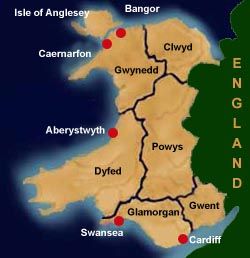 |
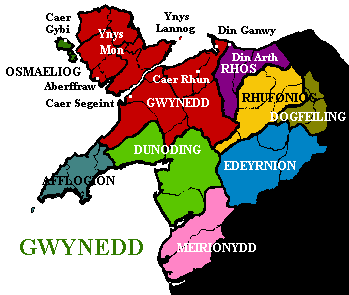 |
||||
| Old Kingdoms | Old Gwynedd |
Gwynedd is now a County in NW Wales, and Meirionydd is an electorate (Meirionydd Nant Conwy) district (Merionethshire) or a pre 1974 county (Merioneth).
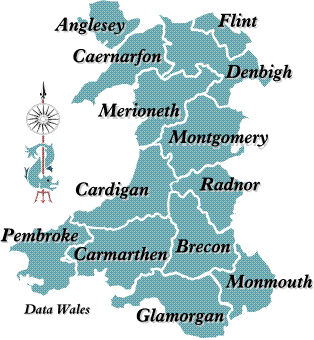 |
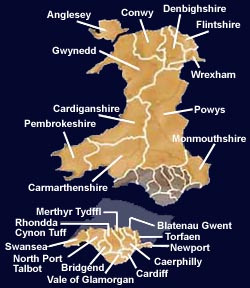 |
||||
| Pre 1974 Counties | Post 1996 Counties |
Bibliography
[1] Britannia.com www.britannia.com/bios/ebk/cadwamd.html
[2] Geoffrey of Monmouth "History of the Kings of Britain" (c.1100 BC-689 AD) in www.britannia.com/history/geofmon.html
[3] http://home.worldonline.dk/~kmariboe/fgspwelsh.html
[4] Early References to a Real Arthur www.britannia.com/history/arthur/karef.html
[5] Gilda's Account www.sci.gu.edu.au/~wiseman/DECB/DECBps.html
[6] Timeline www.sci.gu.edu.au/~wiseman/DECB/DECBbestest.html
[7] Timeline www.britannia.com/history/timearth.html
[8] Uther Pendragon www.mystical-www.co.uk/arthuriana2z/d.htm#DRAGON
[9] Phillips, G & Keatman, M "King Arthur: The True Story" Century 1992 ISBN 0 7126 5580 8
[10] Baker, Mick "Celtic Britain: Owain Ddantgwyn and the Identity of King Arthur" www.historyfiles.co.uk/FeaturesBritain/CymruOwain&Arthur.htm
[11] Baker, Mick "Celtic Britain: Arthur Identified as Cadwaladr of Meirionydd" www.historyfiles.co.uk/FeaturesBritain/CymruArthurCadwaladr.htm
[12] The History Of The Dal Riada Scots And Their Settlement Of Alba www.motherbedford.com/ScottishDalRiada.htm
[13] Gardner, Laurence "Bloodline of the Holy Grail: The Hidden Lineage of Jesus revealed" [Arthurian Descent pg 358, Arthur and the House of Avallon Delacqs pg 361 & Bloodline of the Holy Grail pg 365.] Penguin 2001 ISBN 0 14 100615 3.
[14] Enfield-Bryant Genealogy www.jaenfield.com/genealogy/Enf_Bry/i1391.html#I14629, www.jaenfield.com/genealogy/Enf_Bry/i1391.html#I14629 and www.jaenfield.com/genealogy/Enf_Bry/i145.html#I97357,
[15] Daniel Goonan (Goono): Genealogy - MacAlpin http://home.austarnet.com.au/dfgoonan/MacALPIN.htm
[16] Ford, David Nash "Early British Kingdoms - Early Kingdoms of Scotland Part 2: AD598-714" www.earlybritishkingdoms.com/adversaries/kingdoms/scot598.html
[17] Ford, David Nash "Cynan Garwyn, King of Powys" www.earlybritishkingdoms.com/bios/cynangpw.html
[18] Morganwg, Iolo; Intro & Glossary by Smith, Malcolm "The Triads of Britain" Wildwood House, London 1977 ISBN 0 7045 0290 9
The Triads are also listed on-line at www.tylwythteg.com/triads/triads.html
[19] King Arthur Cylinder for Portable Planetariums www.planetarios.com/arthur.htm
[20] The Family History of Derwas back to BC www.my.familytree.dsl.pipex.com/king_arthur.htm
[21]Chadwick, Nora. 1953. "The Lost Literature of Celtic Scotland: Caw of Pritdin and Arthur of Britain." Scottish Gaelic Studies 7:115–183.
[22] Carroll, David F "Arturius - A Quest For Camelot" www.legendofkingarthur.com/arthur.htm, "The Irrefutable Historical Evidence Of The Existence Of Arthur" www.legendofkingarthur.com/evidence.htm and the full book at www.legendofkingarthur.com/i/arturius.pdf
[23] Whittaker, Kelly d. "A new theory about King Arthur" www.electricscotland.com/history/king_arthur.htm
[24] Our Family History - My Lines: Me, my ancestors, and my relations Robert Brian Stewart Evans, GA.
[24a] Domangart mac Áedán http://homepages.rootsweb.com/~cousin/html/p238.htm#i14462
[24b] Gwenwenin ingen Domangart http://homepages.rootsweb.com/~cousin/html/p188.htm#i11586
[25] Rudmin, John C. and Joseph W. "Arthur, Cerdic, and the Formation of Wessex" 1993 http://camelot.celtic-twilight.com/camelot/rudmin/
[26] Wolcott, Darrell "YNYR GWENT AND CARADOG FREICH FRAS" Ancient Wales Studies www.ancientwalesstudies.org/id25.html